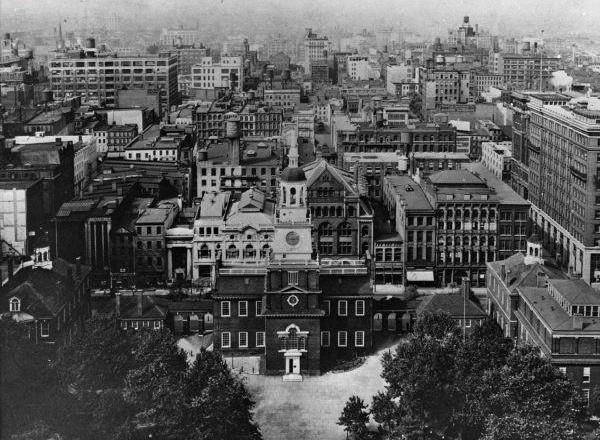
 |
| Independence Mall, date unknown |
Four days into freshman orientation Karen and I turn down a cobblestone street, peer through a wrought-iron gate, and it is unanimously decided: we will move to Old City our senior year. Karen is my high-school-best-friend's girlfriend, never mind that I've always thought she's crazy, or that she's going to cheat on her boyfriend with my friend Joe later this semester. For now we are planning our future as roomies in a quaint Old City apartment with access off of an honest-to-god courtyard.
Karen and I are from New York, not New York City, but close enough to know that Philly is nothing like New York City. Cobblestones and wrought-iron gates are few and far between; New York would never compromise its trendsetting image by naming a neighborhood "old" anything ("vintage" perhaps.)
We emerge from the shaded streets of Old City into the Independence Mall. Karen's Graduate Advisor, a PhD candidate in American History, explains that in the 1950s dozens of 19th century buildings were demolished to create this 18th century panorama. In New York urban renewal means out with the old in with the new, in Philly: out with the old, in with the older. After hijackers attacked two iconic 28-year-old buildings in New York, Philly instituted heightened security surrounding its iconic pre-Revolutionary city-block, Independence Square.
An anonymous soul once told me that Parisians love Philadelphia. Urban renewal à la Hausmann saw narrow alleyways lined with medieval tenements razed to allow for sweeping boulevards and étoiles. But once this feat was accomplished Paris was considered renewed for good, and has largely architecturally remained frozen in the 19th century. In 1901 City Hall, a full block of French Renaissance in the heart of Philadelphia, was completed, and in the 1930s French planner Jacques Gréber designed the Benjamin Franklin Parkway as a "slice of Paris in Philadelphia." But it is the odd marriage of the parkway's pomp and circumstance with Old City's colonial intimacy that reminds me of Paris, where antique alleyways still fill in between Hausmann's vistas. Allen Ginsberg once said, "You can't escape the past in Paris, and yet what's so wonderful about it is that the past and present intermingle so intangibly that it doesn't seem to burden." The same could be said of Philadelphia, where City Hall is still, at least spiritually, the tallest building. It wasn't until 1987 that Philly's half-hearted skyline reached above William Penn's hat to shout "Here!" in the roll call of great American cities. Though of course great-American Philly lies at street level.
I never did move into Old City with Karen, and after seven blissful months in Paris (could you tell?) I am now holed up in Brooklyn, as close to Philly as New York gets, the Manhattan skyline looming in my peripheral vision. Ever step onto a moving sidewalk? That's New York: constant forward motion even when you're standing still; occasional elbow jabs on your left as people stride even faster ahead. Philadelphia's cobblestone streets offer a welcome alternative, a beautiful place to stand.
By ERIN SILVERSTEIN
Back to main page.